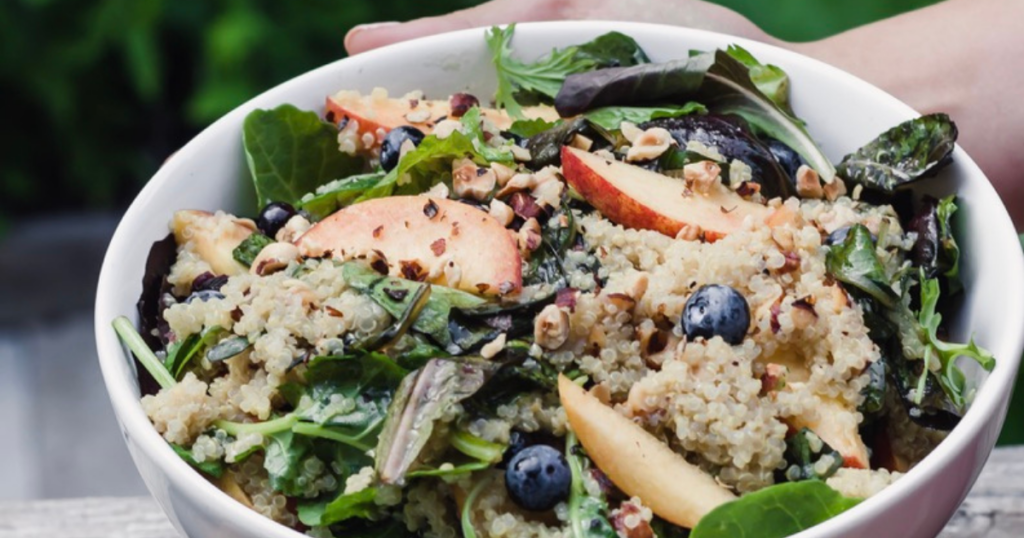The peaceful plate is a visual representation of how to create a balanced plate. But before we dive into the details of what it entails, it’s important that we discuss what balanced eating actually means.

Table of Contents
What is balanced eating?
A balanced meal plan combines knowledge about nutrition and health with the flexibility needed for everyday life. We all need to eat food that gives us energy, provides us nutrients for health and is a good balance of different food groups. Eating in a balanced way also means eating foods you like, respecting your food preferences, and paying attention to your hunger, fullness, and satisfaction.
Balanced eating is based on using nutrition guidelines to make informed food choices while being flexible and continuously figuring out what works for you and your body. When you eat in a way that is healthy for your body, mind, and spirit, you take care of your social, emotional, and mental health at the same time. Balanced eating includes eating a variety of foods during meals and snacks to provide fuel for your body.
The Difference Between Nutrition Guidelines and Food Rules
It’s important to note that nutrition guidelines, (like the peaceful plate and including different food groups in your meals and snacks) differ from rigid food rules. Examples of food rules include not eating past 7pm, only allowing yourself to have dessert on the weekends, or forcing yourself to go to the gym because you’re going out to dinner later. Often food rules take up a lot of our mental space, they’re created by our disordered thoughts and are unfortunately on our minds every time we make a decision about food. Nutrition guidelines, however, are based on mindfulness. Being more mindful about the foods that we’re eating and trying to consume more nutrient-dense foods isn’t rooted in disordered thinking.
What Does a Peaceful Plate Look Like?
When visualizing the peaceful plate, think of the peace sign! For reference, a peaceful plate is split into thirds, with each piece representing a different food group. The “peace sign” in the middle of the plate is also a symbol of “food peace,” since there are many ways to eat. Remember, the peaceful plate is only meant to be a guideline for how to assemble your meals (you do not have to be “perfect” at every meal!). The goal is to listen to your body and have freedom and fun!

In the peaceful plate diagram, 1/3 of the plate is vegetables or fruit, 1/3 is a carbohydrate, 1/3 is a protein, and the center represents a source of fat or fun foods such as dessert! Alongside eating balanced meals using the peaceful plate diagram, it is also recommended to eat at least 2-3 snacks throughout the day – depending on your nutritional needs, your recovery journey, and other factors. For some, it may be helpful to think of snacks as mini-meals that include 2-3 food groups.
Eating like this may seem frustrating at first. It may take some time to get used to shifting your day around if you’re used to eating in a different pattern. This is why balanced eating is flexible and adaptable to YOU and YOUR lifestyle!
Carbohydrate’s Role On a Peaceful Plate
Carbohydrates are the main way that muscles get energy, and they are the only way that the brain gets energy. Whole grains also have antioxidants and fiber, which are good for your digestive health, feeling full, and heart health. Carbohydrates have B vitamins that help the body use energy and iron that helps oxygen get to all parts of the body. If you don’t get enough carbs, you might feel tired, depressed, anxious, and have trouble going to the bathroom.
Protein’s Role On a Peaceful Plate
Protein is important for every cell in the body. Protein is used for a lot more than just building muscle. It helps blood clot, boosts the immune system, and repairs damaged tissues. Meat is a good source of protein because it has a lot of iron and vitamin B12. Iron helps carry oxygen through the blood, and vitamin B12 is needed for energy metabolism. If you don’t get enough protein, you can lose muscle, have a slow metabolism, have less energy, and have an electrolyte imbalance.
Fruit’s & Vegetable’s Role On a Peaceful Plate
Fruits and vegetables are nutritional powerhouses because they have a lot of antioxidants, phytonutrients, vitamins, minerals, and fiber in them. They keep us from getting sick and make our immune systems stronger so they can fight off metabolic stress. If you don’t get enough fiber, it can weaken your immune system, make you more likely to get sick, and cause eye and skin problems.
Fat’s Role On a Peaceful Plate
Eating fat is essential for optimal health and very low fat diets cause major health risks. Fat not only gives you energy that lasts, but it also keeps your organs warm and keeps your body temperature stable. All of the body’s cells are protected by a layer of fat. Fatty acids are turned into important hormones like vitamin D and help the body absorb many other vitamins. Some fats, like omega-3s, can even reduce inflammation and lower the risk of heart disease. If you don’t eat enough fat, you may have trouble getting pregnant, feel tired, heal slowly, or have problems with your liver or kidneys.

What About Serving Sizes?
Serving sizes are NOT a recommendation of what to eat or drink! Instead, serving sizes are updated to reflect the amount people typically eat and drink. Serving sizes are also used as a reference point for the nutrition info you see on food packages (the Nutrition Facts Label). Instead of being hyper-fixated on portion sizes when eating packaged foods, try to use gentle nutrition, hunger, and satisfaction cues to help you navigate how much to eat. Try asking yourself:
- How hungry do you feel before eating?
- How hungry do you feel while eating?
- Would this food be more nutritious and satisfying if I paired it with something?
- How will I feel if I eat more/less of this food right now?
Bottom line: The peaceful plate can be a helpful tool to use to help make your meals balanced so you can ensure that you’re nourishing your body with all of the essential nutrients it needs. For more support on how to build a peaceful plate, talk to one of our Registered Dietitians today!






0 Comments